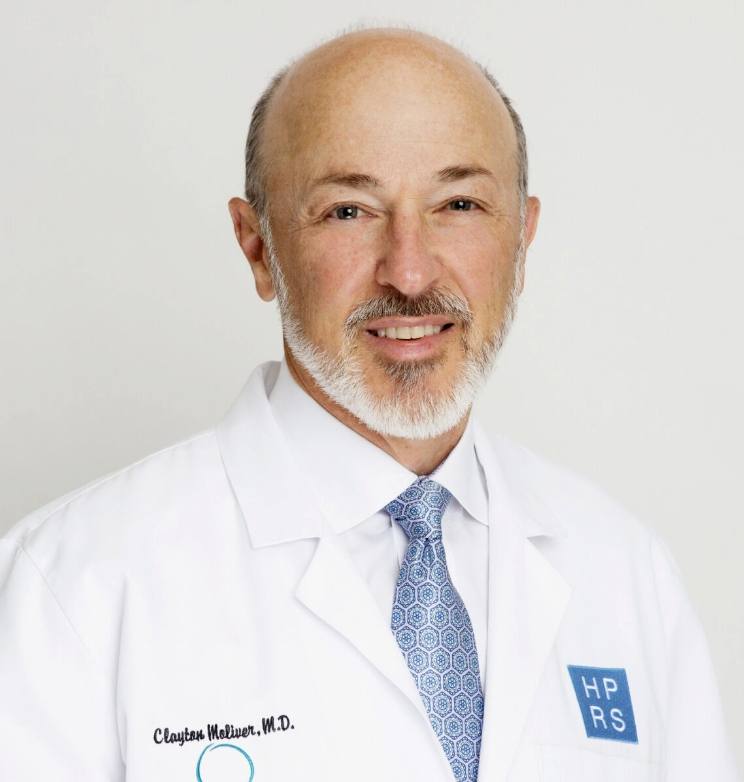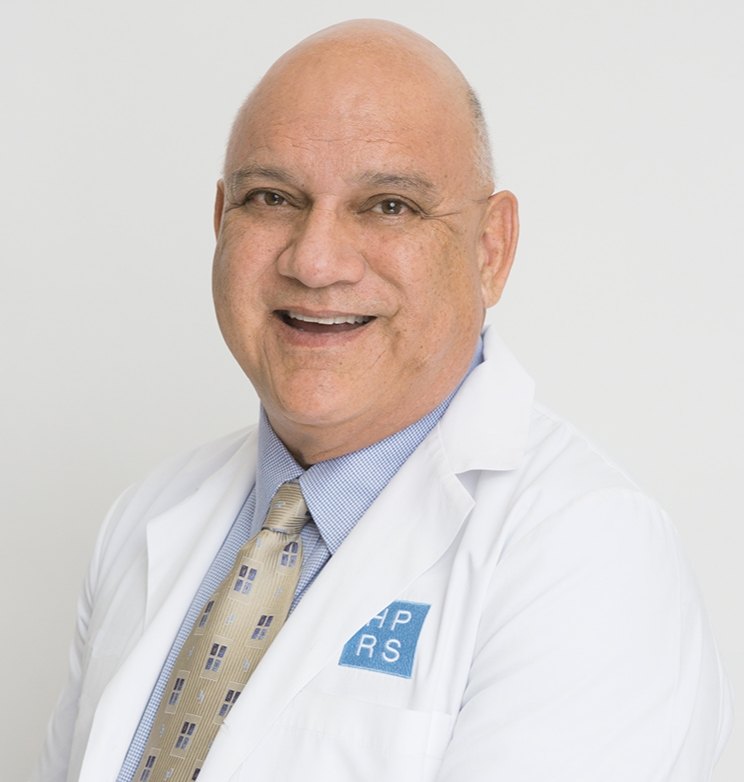- Surgeon’s professional fee
- Facility fee
- Anesthesia fee
- It does not include any laboratory tests, preoperative examinations, garments or postoperative prescriptions.

Clear Lake
Houston Plastic and Reconstructive Surgery
575 East Medical Center Boulevard
Webster, TX 77598
Phone: (281) 282-9555
Monday–Friday: 8 a.m.–5 p.m.
Med Center/Museum District
Houston Plastic and Reconstructive Surgery
1801 Binz Street #300
Houston, TX 77004
Phone: (713) 521-4777
Monday–Thursday: 8 a.m.–5 p.m.
Forehead Lift
Have you ever wondered how a forehead lift might change your appearance? Here’s a quick preview: Stand in front of a mirror and place the palms of your hands at the outer edges of your eyes, above your eyebrows. Then gently draw the skin upward to raise the brow and forehead area. That is approximately what a forehead lift would do for you.
FAQs About Forehead Lift Surgery
Am I a Good Candidate for Forehead Lift Surgery?
Any one or combination of the following conditions may indicate that you are a good candidate for a forehead lift at our practice in Houston and Webster:
- Sagging or low position of the eyebrows, creating a tired or sad appearance
- Deep horizontal creases across the forehead
- Frown lines, or furrows, between the eyebrows and sometimes across the top of the nose
The face usually portrays the first visible signs of aging. Gravity and changes in eyebrow shape and position results in the brow area looking aged. Most patients requesting evaluation for a forehead lift or facelift feel that their facial features do not reflect their youthful spirit and energy level. They are looking for ways to refresh and rejuvenate their appearance. There are many different variations of the forehead lift procedure that improve the position and shape of the eyebrow and forehead areas. Ultimately, the lift will allow you to turn back the hands of time to better reflect your youthful spirit.
How Will I Be Evaluated for a Forehead Lift?
During the preoperative consultation, one of our plastic surgeons will perform a history and physical examination. During your physical examination, your facial bone structure, underlying skin structure, brow position, eyelid and eye aesthetics, skin thickness, texture and elasticity will be assessed. This information will be used to formulate a surgical plan and the goals of the procedure will be discussed. Generally, a forehead lift procedure is a very versatile procedure, and your surgeon will explain the technique that he feels most comfortable with and that offers the lowest risk. Your surgeon will select the surgical technique that he feels will obtain the best outcome for you based on your discussions regarding the outcome you wish to achieve.
How is a Forehead Lift Performed?
The forehead lift procedure continues to evolve. Over the years, the procedure has changed from open techniques to more complex short incision and endoscopic techniques. The forehead lift procedure usually involves incisions in the hair-bearing scalp. Occasionally, incisions may be performed in the forehead, and/or the upper eyelids. Once the incisions are made, various degrees of undermining of the skin are performed, and the deeper layers of the forehead are “lifted.” Muscles that depress the eyebrows may be disrupted. The skin and deeper layers are often then “fixed” or attached to the bone. The results are a reversal of the effects of gravity and tightening of soft tissues of the forehead to restore a more youthful contour to the upper face.
How is My Surgeon Able to Improve My Frown Lines and Eyebrow Position?
In many instances, an incision is made across the top of the scalp, beginning above the ears and hidden within the hair. Sometimes, the incision may be placed at the front of the hairline or, in some cases, toward the middle of the scalp. The incision is designed to be inconspicuous when healed. Through the forehead lift incision, your surgeon can modify or remove parts of the muscles that cause wrinkling and frown lines, remove excess skin, and lift your eyebrows to a more pleasing level.
Sometimes, if your main concern is frown lines between your eyebrows or across the top of your nose, a limited endoscopic procedure to correct these problems can be done.
How Much Will a Forehead Lift Cost?
Cost is always a consideration in elective surgery. We always present our plastic surgery consultation patients with a “fee quote.” This fee includes:
Please see our Payment Options page for more information.
Payment Options
We’ll work with you to make your aesthetic dreams come true. We offer flexible financing plans to meet most budgets.
Learn MoreUnderstanding Risks of Forehead Lift Surgery
Fortunately, significant complications from forehead lifts are infrequent. Every year, thousands of people undergo successful forehead lift surgery and are pleased with the results. However, anyone considering surgery should be aware of both the benefits and risks.
Some of the potential complications that may occur include hematoma (an accumulation of blood under the skin), infection, and reactions to anesthesia. While our surgeons have performed many forehead lifts safely manipulating facial skin and tissues, injury to underlying structures is possible, though usually temporary. Forehead lift incisions are usually quite inconspicuous; however, this is not entirely predictable due to individual variations in healing. You can help minimize certain risks by following the advice and instructions given to you both before and after surgery.
Meet Our Plastic Surgeons
Each plastic surgeon on our team has the training, experience, and talent needed to provide the natural-looking results patients want while ensuring their safety and comfort.
Request Your ConsultationYour Forehead Lift Surgical Experience
In many instances, an incision is made across the top of the scalp, beginning above the ears and hidden within the hair. The goal of your plastic surgery team is to make your surgical experience as easy and as comfortable as possible.
Preoperative
If you are a smoker, it is highly recommended to stop smoking well in advance of the surgery. Certain medications that increase the risk of bleeding such as aspirin, non-steroidal anti-inflammatory medications, and some vitamins/homeopathic regimens should be discontinued prior to surgery. If your hair is short, you may want it to grow out enough to cover your incisions while they heal. Any chemical processing of your hair should be performed prior to surgery since you cannot have any of these procedures for a month or more after surgery. Be sure to arrange for someone to drive you home and stay with you for at least the first night following surgery. We can keep a patient overnight. Still, it is wise to have someone available for the first day or two at home.
Day of Surgery
Another forehead lift technique uses an endoscope, a long, thin tube with a light on the end, attached to a video camera. The endoscope is inserted through several tiny incisions in the scalp and allows the plastic surgeon to see and work on the various internal structures of the forehead. The endoscopic technique has the advantage of requiring very minimal incisions, but it may not be equally beneficial for all patients. In some instances, alternate methods may be preferable, or a combination of endoscopic and other techniques may be used.
We were the first practice in the Bay Area to perform endoscopic forehead lifts in an AAAASF facility. We have a very experienced endoscopic team and facility right at our outpatient OR.
These procedures are almost always done under general anesthesia. For your safety during and after the operation, various monitors are used to check your heart, blood pressure, pulse and the amount of oxygen circulating in your blood.
When surgery is completed, you will be taken into a recovery area. A bandage may be wrapped around your forehead or face. Sometimes small tubes will be inserted beneath the skin to drain away fluid that might otherwise accumulate. There is surprisingly very little discomfort experienced after forehead lift surgery. However, any discomfort you may experience will be controlled with pain medication as needed.
You may be permitted to go home after a few hours, although some patients may stay overnight.
Recovery
It is important to realize that the amount of time it takes varies greatly between individuals. Elevation of the head is extremely helpful in reducing the initial postoperative swelling. We advise you to use ice packs intermittently.
You should avoid aspirin and non-steroidal anti-inflammatory medications for the first few days after your surgery. Smoking and exposure to second-hand smoke should be avoided to prevent delays in the healing process.
How Will I Look and Feel Initially After Forehead Surgery?
Once the dressings and drains are removed, puffiness and discoloration may be more pronounced in some portions of the face than others. Do not be alarmed by any unevenness or temporary asymmetry. This is normal. Most swelling is usually noted in the first 24 to 48 hours, and most bruising resolves within two weeks. Concealing makeup is usually permitted after the first week. You may experience numbness to the forehead post-operative, which usually resolves within several months.
Some patients find that mild swelling persists for many weeks. Most stitches are removed within a week of the surgery.
Straining, bending, and lifting should be avoided during the early postoperative period as these activities may predispose you to bleeding.
You will be given specific instructions that may include caring for the dressings and incisions, directions for your analgesics and other medications, specific concerns to look for, and when to follow up in the office to monitor your healing process. It may take several months for the swelling to fully resolve, and up to six months for the incision scars to fully fade. Avoidance of factors that could reduce the benefits of the surgery, such as excessive unprotected sun exposure and cigarette use, is vital.
Results of Your Forehead Lift
The results of your brow lift may be subtle or dramatic, depending on your appearance prior to the surgery as well as the specific goals that you and your plastic surgeon have established. Since the healing process is gradual, you should expect to wait several weeks for an accurate picture of your “new look.” Additional minor changes or settling may occur over several months following your surgery.
Maintaining a Relationship with Your Plastic Surgeon
You will return to our office for follow-up care at prescribed intervals, at which time your progress will be evaluated.
Please remember that our relationship with you does not end when you leave the operating room. If you have questions or concerns during your recovery, or need additional information at a later time, you should contact us.
Back to Top

